CdS/metallic organic frame composite photocatalysis material as well as preparation method and application thereof
A metal-organic framework, composite photocatalysis technology, applied in organic compound/hydride/coordination complex catalysts, chemical instruments and methods, physical/chemical process catalysts, etc. , CdS instability, weak adsorption capacity and other problems, to achieve the effect of improving photoelectric stability, improving photostability, and photocurrent stability
- Summary
- Abstract
- Description
- Claims
- Application Information
AI Technical Summary
Problems solved by technology
Method used
Image
Examples
Embodiment 1
[0049] Preparation of CdS / ZIF-8 and Its Photocatalytic Reduction of CO 2 Performance Testing
[0050] Step (1): Preparation of CdS nanomaterials
[0051] 7mmol thiourea, 7mmol Cd(NO 3 ) 2 4H 2 O and 7mmol PVP were dissolved in 70ml ethylene glycol to obtain a clear solution, then, the mixed solution was transferred to a 100ml tetrafluoroethylene-lined stainless steel autoclave, and kept at 120°C for 12h. After cooling the autoclave to room temperature, a certain amount of methanol was added to the resulting solution to make the CdS nanoparticles easier to precipitate. The solution is centrifuged, the precipitate is collected, washed and freeze-dried to obtain the CdS nanoparticles.
[0052] Step (2): Preparation of CdS / ZIF-8 composite material
[0053] First, 32 mg of CdS nanoparticles were dispersed in 10 ml of methanol and homogenized by ultrasonication, and then 0.2974 g of Zn(NO 3 ) 2 ·6H 2 O was dissolved in 50ml of methanol, the two were mixed while stirring and...
Embodiment 2
[0057] Preparation of CdS / ZIF-67 and Its Photocatalytic Reduction of CO 2 Performance Testing
[0058] Step (1): Preparation of CdS nanomaterials
[0059] 7mmol thiourea, 7mmol Cd(NO 3 ) 2 4H 2 O and 7mmol PVP were dissolved in 70ml ethylene glycol to obtain a clear solution, then, the mixed solution was transferred to a 100ml tetrafluoroethylene-lined stainless steel autoclave, and kept at 120°C for 12h. After cooling the autoclave to room temperature, a certain amount of methanol was added to the resulting solution to make the CdS nanoparticles easier to precipitate. The solution is centrifuged, the precipitate is collected, washed and freeze-dried to obtain the CdS nanoparticles.
[0060] Step (2): Preparation of CdS / ZIF-67 composite material
[0061] First, 32 mg of CdS nanoparticles were dispersed in 10 ml of methanol and homogenized by ultrasonication, and then 0.2379 g of CoCl 2 6(H 2 O) Dissolve in 50ml methanol, mix the two while stirring and continue to stir ...
PUM
| Property | Measurement | Unit |
|---|---|---|
| concentration | aaaaa | aaaaa |
Abstract
Description
Claims
Application Information
 Login to View More
Login to View More - R&D
- Intellectual Property
- Life Sciences
- Materials
- Tech Scout
- Unparalleled Data Quality
- Higher Quality Content
- 60% Fewer Hallucinations
Browse by: Latest US Patents, China's latest patents, Technical Efficacy Thesaurus, Application Domain, Technology Topic, Popular Technical Reports.
© 2025 PatSnap. All rights reserved.Legal|Privacy policy|Modern Slavery Act Transparency Statement|Sitemap|About US| Contact US: help@patsnap.com



